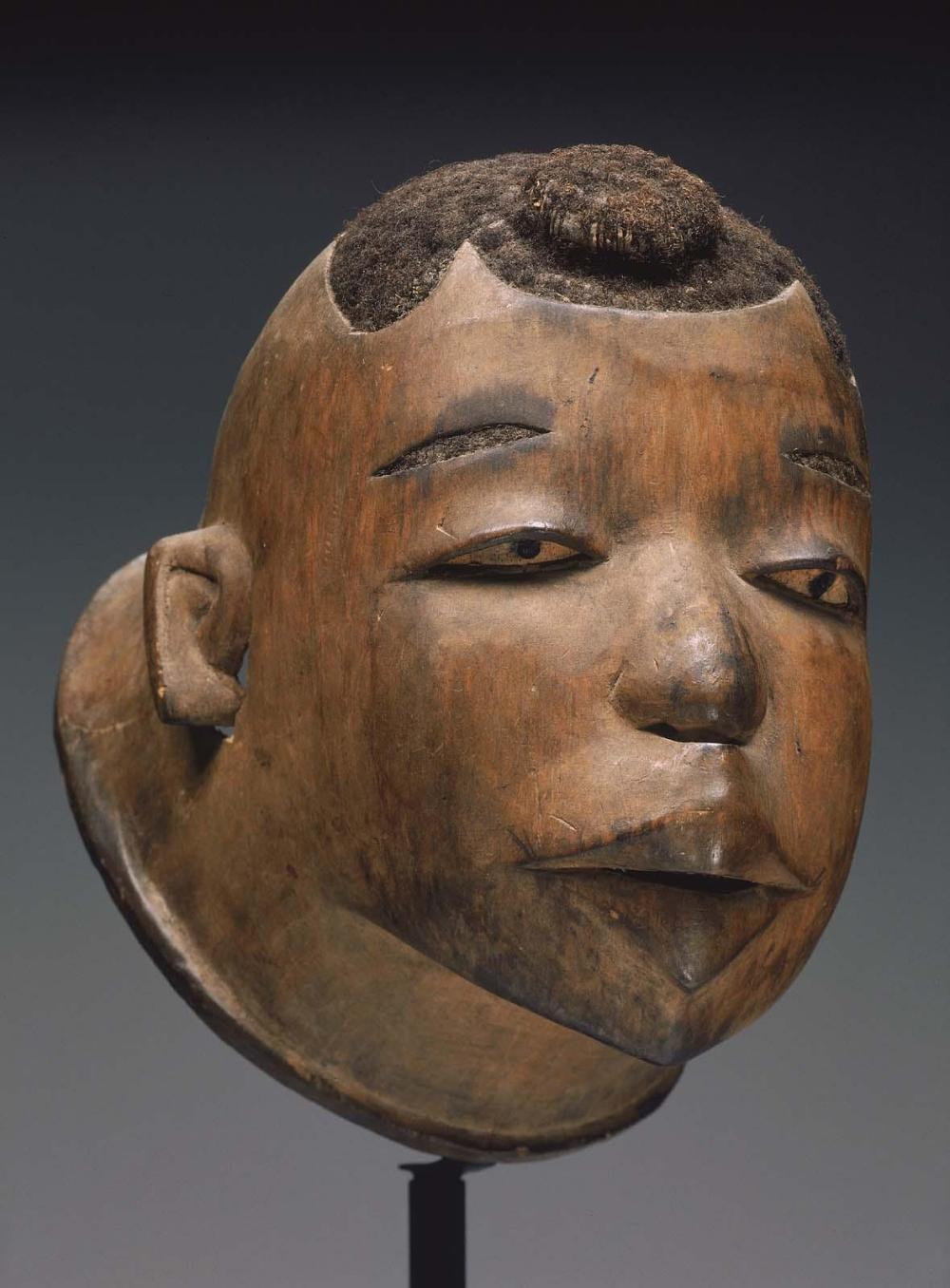Advanced Search 
Dancing with quick steps in the center of town, a man would have supported this mask on the top of his head, his eyes looking out from the mouth of the mask. The smooth skin and finely carved eyes and ears create an idealized face; the slightly parted lips seem ready to speak. The mask portrays a local Makonde man. A fabric ruff and a tight costume would have concealed the dancer, leaving only his hands and feet visible to the crowd. In collaboration with the sculptor and the musicians, a young man would have commissioned this mask and developed a new choreography to express its character. The dance is both a celebration and an opportunity for public examination of important topics—politics; recent events in the village, such as a scandalous romantic affair; or daily events like cooking, reading, or hunting—communicated through both realistic representation and satire. In performance, the lipiko is simultaneously considered an ancestral spirit, a man, the mask, and a character in the narrative of the dance.
This mask was made during a time of significant political change in the Mueda plateau, an area in northern Mozambique. The Portuguese occupation of Mozambique had previously not reached this area, but when Portuguese businesses began to see the plateau as a resource for cotton production, political domination quickly followed. The colonial government used forced labor and tax laws to ensure a steady supply of laborers on plantations and cotton for textile mills in Portugal. Village elders were pressured to cooperate with the colonial state. In response, thousands of young Makonde men and women moved north into Tanzania, returning home to visit with new ideas and imported luxuries. During this period, the style of Makonde masks changed. The abstract idealism evident here, with tiny lines conveying the nostrils, and delicate spirals to indicate the ears, began in the 1930s. This style may have been developed by older men, who wished to assert the ancestral component of the masquerade that younger people increasingly challenged. Younger dancers in this period also commissioned masks in the abstract style but introduced new subjects, like the mask of the Sikh trader that is also in the MFA collection (2014.1968), to convey the increasingly cosmopolitan faces of Makonde daily life.

Mask (lipiko)
Makonde
1930-1955
Object Place: Mueda plateau, Cabo Delgado province, Mozambique
Medium/Technique
Wood, hair and pigment
Dimensions
Overall: 22.2 cm (8 3/4 in.)
Credit Line
Bequest of William E. Teel
Accession Number2014.315
CollectionsAfrica and Oceania
ClassificationsMasks
Dancing with quick steps in the center of town, a man would have supported this mask on the top of his head, his eyes looking out from the mouth of the mask. The smooth skin and finely carved eyes and ears create an idealized face; the slightly parted lips seem ready to speak. The mask portrays a local Makonde man. A fabric ruff and a tight costume would have concealed the dancer, leaving only his hands and feet visible to the crowd. In collaboration with the sculptor and the musicians, a young man would have commissioned this mask and developed a new choreography to express its character. The dance is both a celebration and an opportunity for public examination of important topics—politics; recent events in the village, such as a scandalous romantic affair; or daily events like cooking, reading, or hunting—communicated through both realistic representation and satire. In performance, the lipiko is simultaneously considered an ancestral spirit, a man, the mask, and a character in the narrative of the dance.
This mask was made during a time of significant political change in the Mueda plateau, an area in northern Mozambique. The Portuguese occupation of Mozambique had previously not reached this area, but when Portuguese businesses began to see the plateau as a resource for cotton production, political domination quickly followed. The colonial government used forced labor and tax laws to ensure a steady supply of laborers on plantations and cotton for textile mills in Portugal. Village elders were pressured to cooperate with the colonial state. In response, thousands of young Makonde men and women moved north into Tanzania, returning home to visit with new ideas and imported luxuries. During this period, the style of Makonde masks changed. The abstract idealism evident here, with tiny lines conveying the nostrils, and delicate spirals to indicate the ears, began in the 1930s. This style may have been developed by older men, who wished to assert the ancestral component of the masquerade that younger people increasingly challenged. Younger dancers in this period also commissioned masks in the abstract style but introduced new subjects, like the mask of the Sikh trader that is also in the MFA collection (2014.1968), to convey the increasingly cosmopolitan faces of Makonde daily life.
ProvenanceSaid to have been acquired in Tanzania and taken to Europe by a Portuguese missionary. With the Musée Barbier-Müller, Geneva (inv. no. 1027-10). Leopold Häfliger (b. 1929 - d. 1989), Lucerne; December 16, 1989, Häfliger estate sale, Kunst- und Kongresshaus "Rigi-Saal," Lucerne, lot 13 [see note]. 1996, with Sonnabend Gallery, New York. June 5, 1997, sold by Marc Leo Felix (dealer), Brussels, to William Teel, Marblehead, MA; 2014, bequest of William Teel to the MFA. (Accession Date: February 26, 2014)
NOTE: This appears to be identical to a mask in the estate sale of Häfliger's collection; see the Yale Van Rijn Archive of African Art, no. 0038786-02. The mask's earlier collecting history has not been verified, and whether it was owned or simply exhibited by the Musée Barbier-Müller has not yet been confirmed.
NOTE: This appears to be identical to a mask in the estate sale of Häfliger's collection; see the Yale Van Rijn Archive of African Art, no. 0038786-02. The mask's earlier collecting history has not been verified, and whether it was owned or simply exhibited by the Musée Barbier-Müller has not yet been confirmed.
